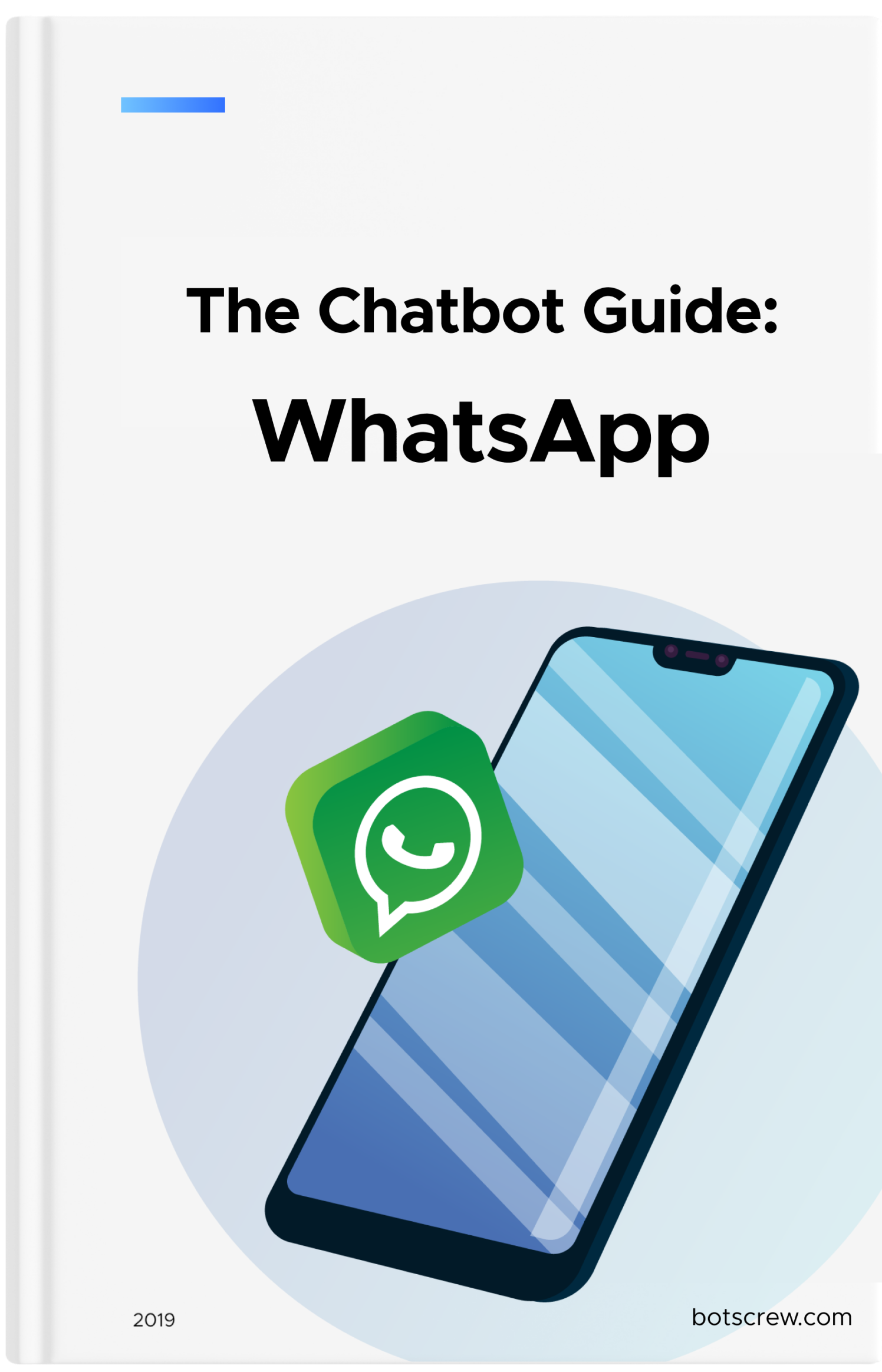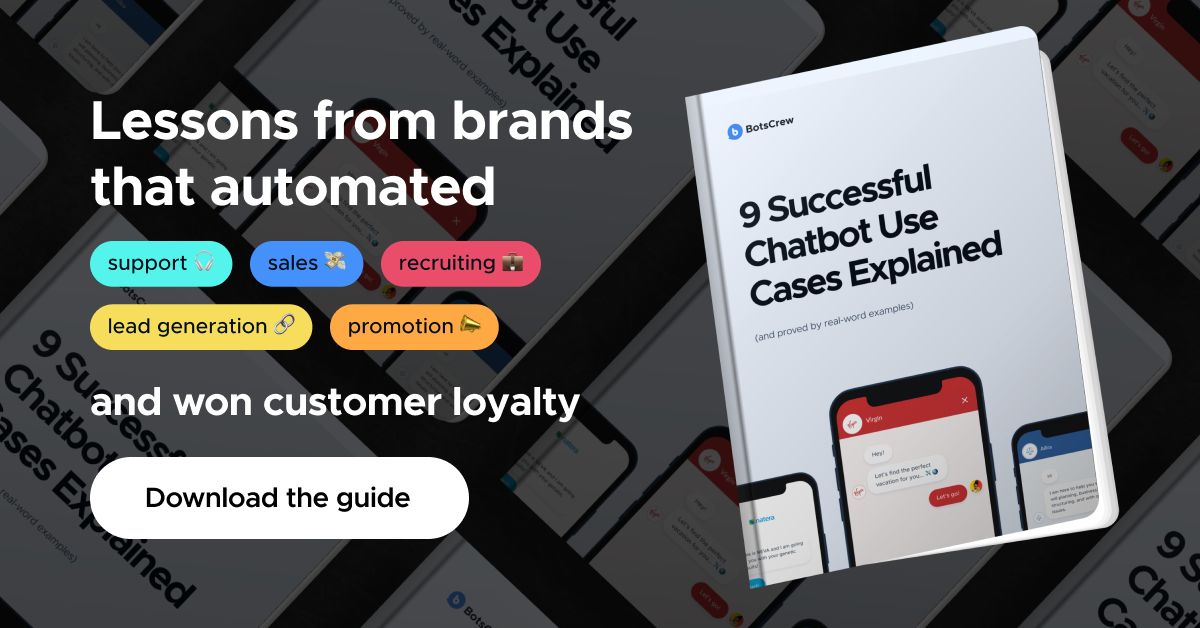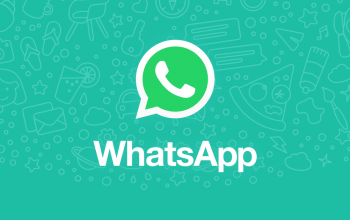SMS Chatbot: A Complete Guide for Business (+ Use Cases)
In this article, we will cover all you need to know about an SMS chatbot in 2023 for your business.
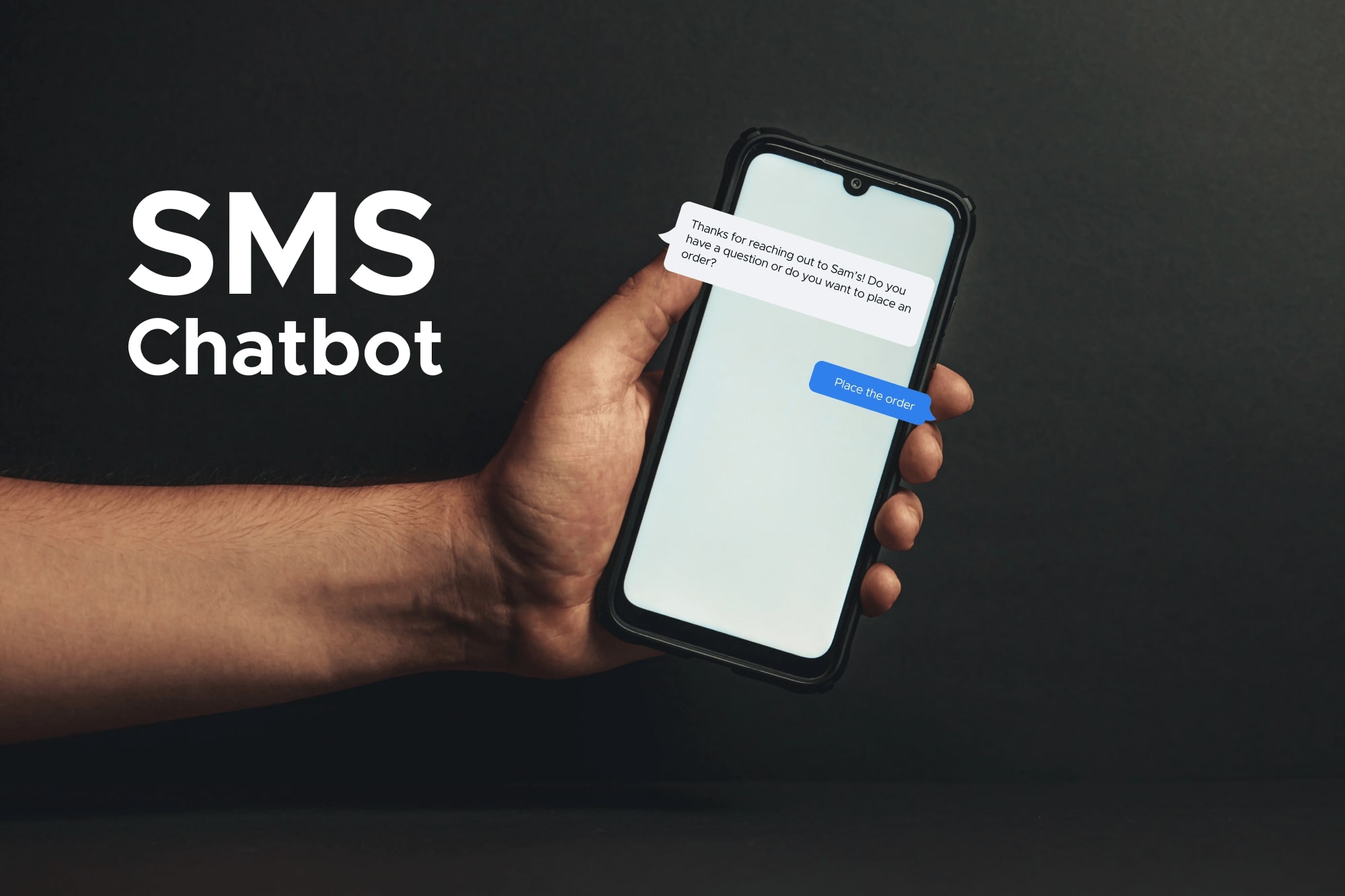
SMS is a popular communication channel adopted worldwide in 1984. Today, there are about 7.26 Billion mobile phone users in the world. This means 91.62% of the world's population can use texting without the need to install any app or have access to the Internet.
The number of mobile users is only growing – in 2021, the worldwide sales of smartphones count up to 1.5 billion units, with an 11.4% growth year over year, according to Gartner, Inc.
Given the coverage, no wonder SMS is actively used by businesses to provide time-sensitive offers, confirmations and shipping updates, any kinds of alerts, and transactional messages. With the adoption of chatbots, SMS marketing has moved even further than that.
What is an SMS chatbot?
SMS Chatbot is a software application that simulates a conversation via an SMS component available on most telephone, Internet, and mobile device systems. It can process the user input and provide a logical answer and/or perform certain actions based on programming.
In simple words, a regular SMS message sent from a business – like a promotion or a welcome message – is a common one-way communication. A chatbot, instead, provides a two-way conversation: it can ask questions, process the answer, and continue the communicational path to subscribe, qualify leads and even sell.
Let’s take a look at an example. Users may receive a text with an event invite. With a regular SMS, there would be a link to the landing page so the user can learn more and sign up there. A chatbot, instead, can actually pick up the conversation from there, provide more info, and sign-up users to attend – even if they don’t have an internet connection.
Subscribe to bi-weekly issues of 👎👍 Bad to Great Chatbot
A 200-word email with insights from people who made great chatbots before
Join 1000+ other business leaders who build successful chatbots. You’ll be the first to know when we publish anything new.
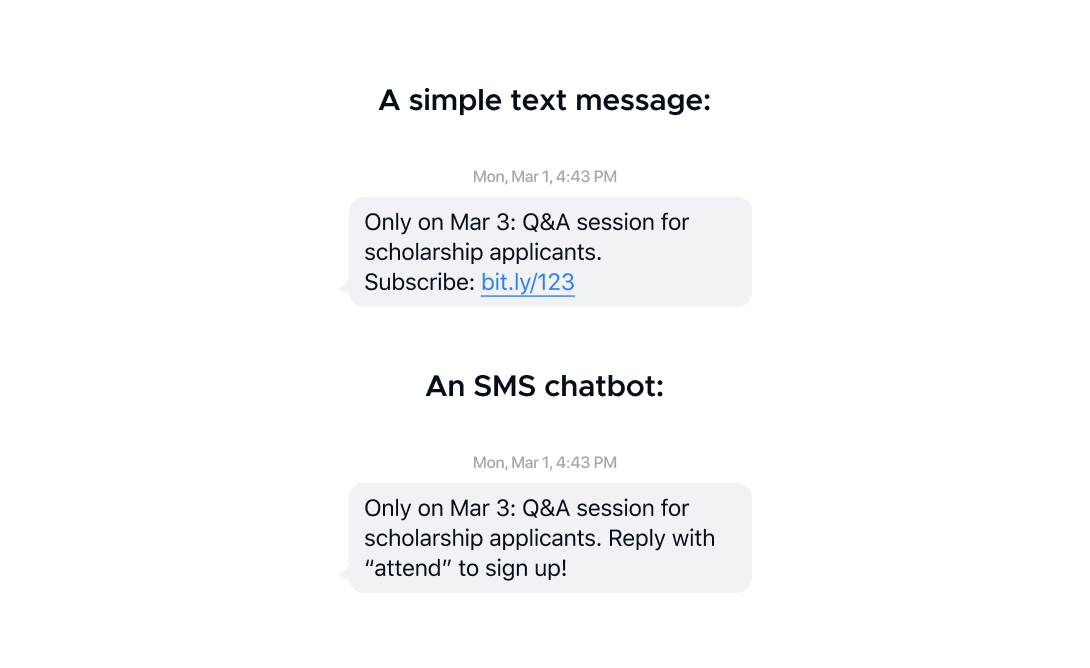
For this particular example, bringing people to react instead of asking to visit the website link increases the chances for conversion. It removes the strain of clicking a suspicious spam-looking link which is usually shortened to fit the character limit of SMS. A chatbot helps to catch the opportunity and start a conversation leading to conversion instead of just delivering the message.
SMS chatbots are used by businesses worldwide. In Australia anyone can order Domino’s pizza via SMS – this is a creative way for a large multinational pizza restaurant to manage orders from returning customers. Once they’ve set the contact details and preferences in their account for pizza, they can order as simply as send one emoji of pizza via SMS. No need to call, visit a website or download an extra app to the phone.
Example of an SMS chatbot – Dominos Pizza:
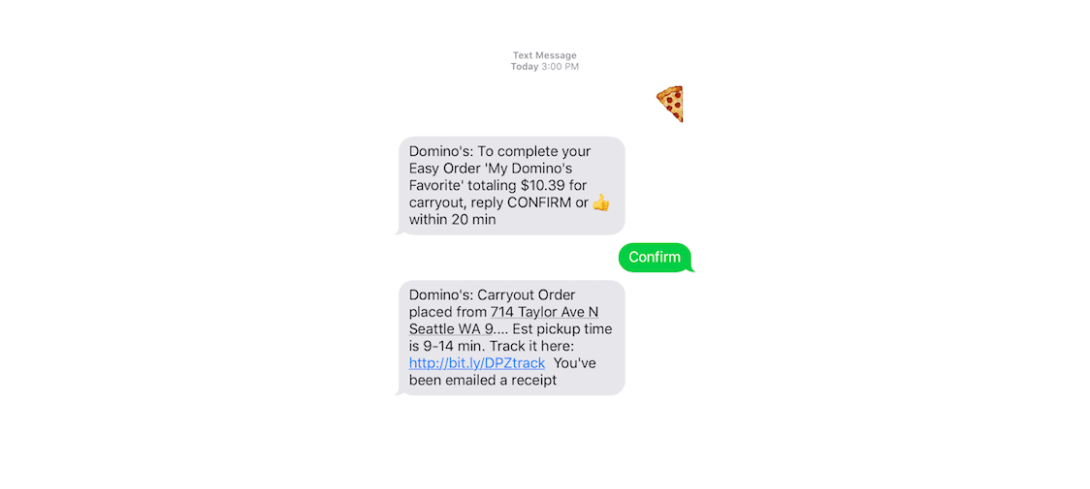
This is a part of “Dominos is Anywhere” campaign – try it out by sending a text of 🍕 or “easy order” to 88607.
Why use an SMS Chatbot for business?
Chatbots are not new: you may see the website, phone, messaging app chatbots running live for many businesses. So why use SMS in combination with a chatbot?
Large coverage
SMS option is available natively on any mobile device as long as it supports access to the network. With 7.26 Billion mobile phone users in the world, 9 out of 10 people could potentially receive a text message from a business.
As for popular messaging apps (WhatsApp, Facebook Messenger, etc.), about 3.32 Billion people use them worldwide. SMS wins the reach over apps, making it the most available messaging channel.
A simplified offline touchpoint for all
To receive an SMS, users don't have to download apps to see your message. They don’t even need an Internet connection – users will receive it immediately without entering any website or checking the mailbox. Also, SMS works even on early models of phones, so you don’t have to bother with adaptability, plain text versions, and QA before launching your campaigns. This way, a business can reach users of any age, country of residence, financial status, and level of digital literacy.
Higher open & response rates
A chatbot running on SMS can help a business be noticed & engaged with by users on a larger scale compared to other channels available via the Internet. According to Gartner, SMS open rates run as high as 98% compared to the email’s 20% mark. As for the response rates, SMS hit the mark of 20% while email remains at 6%. This means nearly 20% of people could potentially enroll in a marketing activity or start a chat with a business via SMS.
SMS channel is underestimated
Using SMS can be a great competitive advantage as most companies prefer business messaging apps or web-based communication. SMS allows you to send important notifications that won’t be lost among massive outreach campaigns with promotions and spam that your competitors send. With high open rates stats as indicated above, you may be sure your message will be read.
No time or app-related limits
SMS does not fall under the limits of 24-hour windows like on WhatsApp. Feel free to reach and engage with users as long as they’ve given consent to receiving SMS messages from the business. NOTE: The SMS regulations can differ per country. But in general, you must have consent from the user or the user starts the conversation. For example, in the United States, there are certain rules written down in the TCPA.
How a Chatbot Powers SMS Messaging
Chatbots can be trained to perform automated actions boosted with Machine Learning, Artificial Intelligence, and Natural Language Processing (NLP). They power up the ability of a computer to give a relevant response based on user input. There are a few types of bots that made their way into business use.
For example, rule-based chatbots can provide a reply or suggest choices out of predefined answers. These bots are among the most widely used for marketing purposes (like promotions) and simple user flows that don’t require too many questions. Within an SMS chatbot, the user will need to type the answer indicated in your previous message to keep the conversation going.
With Natural Language Processing, bots can understand the context of a conversation. When the users reply in their own words, the chatbot will be able to process the answer. This is possible as the essence of user replies is powered with language recognition in code. A chatbot will understand the core of a reply either fully or partially and will provide an appropriate reply as defined in the flow. These bots emulate close-to-real conversation.
Any of these bots will require a tree of choices for each possible answer. What happens next for each input? You are free to build the flow in a way your business demands. The more defined it is, the better the chances are that the conversation will be successful. Here you can find more info about how to train your chatbot.
Overall, by implementing a chatbot, you’re hiring a digital assistant to support effective communication 24/7 even when your support agents are offline. This is a powerful feature as compared to regular SMS messaging, which sends SMS without receiving a reply from a customer. A chatbot can pick up the communication from there, whether it was started from massive outreach or initiated by a user.
To make SMS messaging truly exceptional, chatbot arms you with numerous integrations for personalization.
This could be:
- CRM ( e.g., Hubspot, Zoho, Salesforce, etc.);
- Calendar or Booking Engine (Google Calendar, etc.);
- Payment system (e.g., Stripe, PayPal, etc.);
- Maps (Google Maps, Apple Maps, etc.);
- other business software that your company is using.
A chatbot can do much & much more. Check out the chatbot development guide to see all opportunities.
So, what can a chatbot do for a business?
The capabilities of SMS chatbot training are as broad as for web or messaging app-based bots. Although, there are some specifics of an SMS channel that you should keep in mind before building an SMS-based bot. We covered them in the section ”Understanding SMS Chatbot Specifics”.
Chatbots can subscribe for events, navigate to landing pages, send personalized reminders, and even sell in a conversational way. The final goal is set with a conversation script. Read more about general chatbot features and training capabilities here.
Some business applications of SMS chatbots are: generating leads, providing product surveys, qualifying clients, etc.
SMS Chatbot Use Cases
SMS Chatbots can be used independently or complement some of the communication channels that you’re already using.
As an independent touchpoint, a chatbot could guide users to a specific conversion goal. For example, collect feedback or navigate through a separate promotion campaign. Given the SMS specifics, a chatbot is a great choice for simple campaigns with straightforward goals.
As a complementary channel, a chatbot could send actionable notifications. SMS can be an addition to existing web apps by providing links to the main resource and sending time-sensitive notifications when the user doesn’t interact with other channels. It’s a great way to return users back.
To get a chatbot conversation started, a user or a business should send a specific message.
A business can reach users with an opening message in a massive outreach campaign. Once users reply, the chatbot starts working. In the same way, if users send a text message to a business phone number, they initiate the conversation. It can be as simple as sending an emoji or typing something as simple as “Y”.
As SMS is widely used by marketers as a mass reach send-out, a chatbot can personalize the outreach in many cases. Below we collected some common SMS chatbot use cases to show how bots work for businesses.
Actionable reminders
SMS bots can notify your users, for example about having received an order, or a message with information about the delivery time of a package.
Another way is to remind the customer about upcoming events with personalization. For example, here’s what a friendly reminder may look like:

Based on user input, a chatbot can go even further – give an option to change the date or cancel the appointment. Like this:

The option to act on your notification is very useful when it comes to events. This way, businesses can make sure the customer will show up or update the availability on spot, so the others could grab the opportunity.
Marketing promotions that talk
SMS as a channel is widely used for promotional activities. With a chatbot, users have a chance to react and start a conversation. Such an approach will boost engagement and will make your offer stand out from the others.
For example, if you’re running some retention campaign with a birthday special, a chatbot can initiate a chat with a message like this:
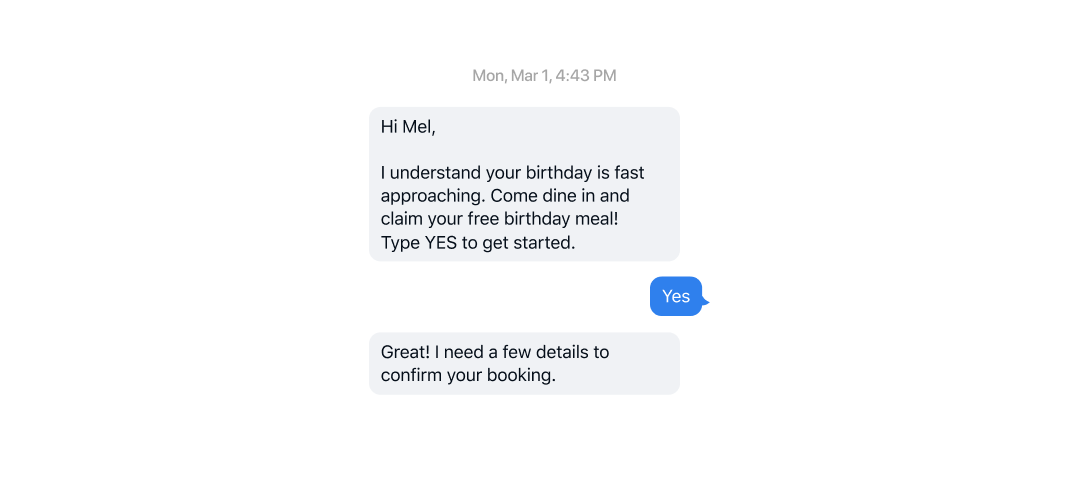
Once the user replies, the chatbot can move on and schedule the date for a birthday meal in a few messages. No sudden calls or flows of emails. Easy!
Simple surveys
SMS chatbots are a great tool when it comes to surveys. Users may reply with numbers or simple words to a list of questions that are sent in messages. Those may be the customer satisfaction surveys, specific topic-based polls, etc.
The easier the answer is, the higher is the chance that the user will reply.

Live support channel
With SMS, businesses can even provide full SMS customer service. Just like in a live chat, a bot can accept responses and navigate to a page, FAQ or connect with a support agent.
Bots can accept not only answers like “Y”/”N” but understand the user input and context. For example:
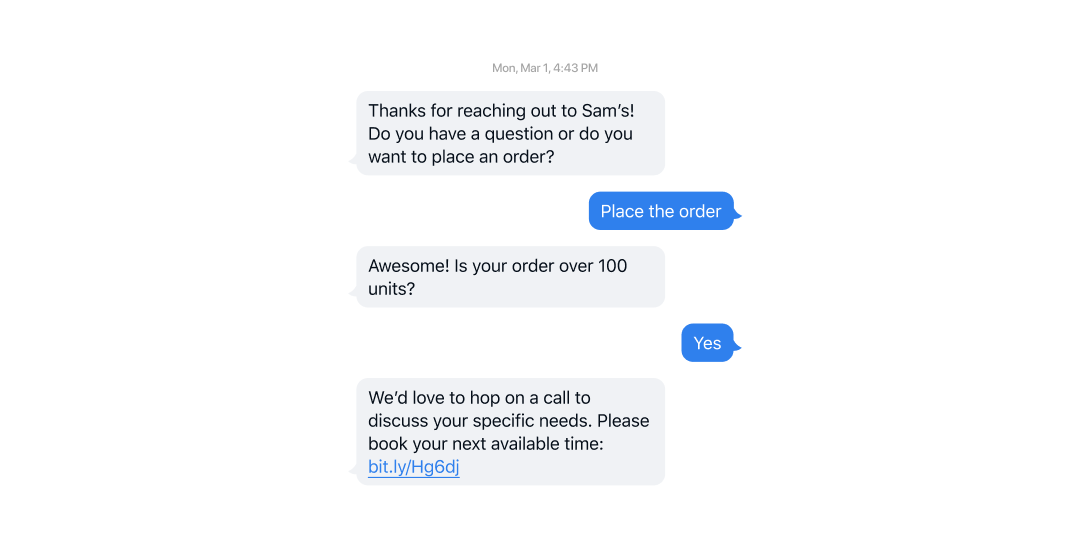
You may ask – how can I make sure users will reach my business via text?
If your business uses social media, add a “Text” button to your Instagram bio. Adding a text-enabled phone number will encourage more users to text you. A chatbot will pick up the customer request on the other end.
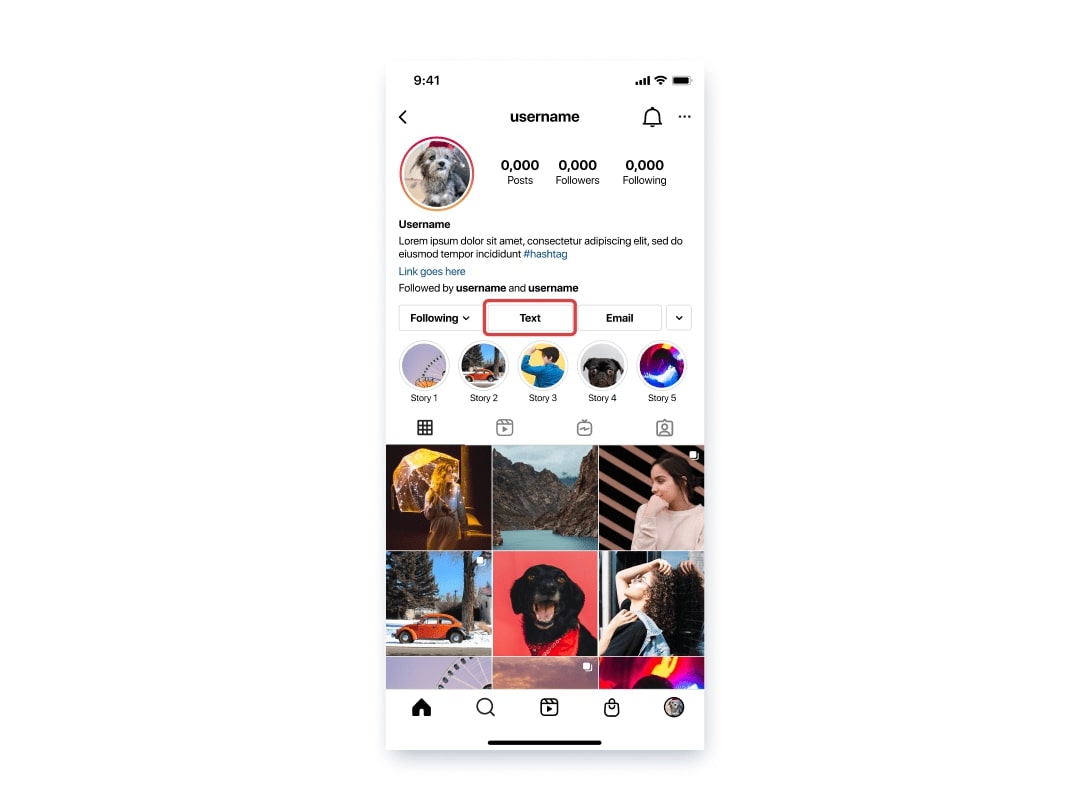
You can also add “Call OR Text Us” anywhere your phone number appears: website, business cards, email signature, etc. It’s simple to take advantage of any digital or traditional advertising and engage in a text conversation with potential customers on channels you’re already using.
Understanding SMS Specifics
One of the most important is that the SMS channel does not have quick reply buttons as in web or messaging app-based bots. The user will need to type and send the reply to keep the flow going. This means the text of each message should include a clear CTA for the next step, as well as indicate the type of response that the bot is expecting. Is it an input or a choice from the previous message? Users should get it straight.
Another point is media limits. SMS does not allow sending videos or attachments. You may send an image with an MMS but keep in mind the cost of it is different than for a text-only SMS.
Pricing is another note for planning campaigns. Pricing for text message services varies depending on several factors: the vendor, how many messages you need to send monthly, and whether you expect to exceed your monthly limits at all. Most texting plans include a per-text cost and the cost of renting keywords for campaigns. As you use bulk campaigns, discounts are usually available. Check your local operator costs for more info.
With SMS bots you should also keep in mind the character limit. A single SMS message should include no more than 160 characters encoded using the GSM-7 character set. Messages not encoded with GSM-7 are limited to 70 characters. If the message is larger, it will be sent in two or more messages. With the character limit, any message content should be specific and to the point.
Another important note is about user consent.
Any interaction with a user must have consent. Such limits are set even for web or messaging app bots. SMS is no different. If you’re planning to use an SMS chatbot for follow-ups or massive send-outs (for SMS marketing), make sure you’ve collected user consent for opting into your campaigns. There are many ways to opt-in – rule #1 is to display an explanation that individuals who sign up for SMS are consenting to receive text messages from your business.
If you’re gathering contact information via the website form, you may want to include this info right on the form.
Some other ways for users to subscribe are:
- Send a special text to your phone number. For example, users may get an offer with a discount through one of your marketing channels (website, email, WhatsApp, etc.) and sign up by sending a special code by SMS;
- Enter a phone number into a website form with the required terms;
- Sign up in-person at a physical location using a form with required terms.
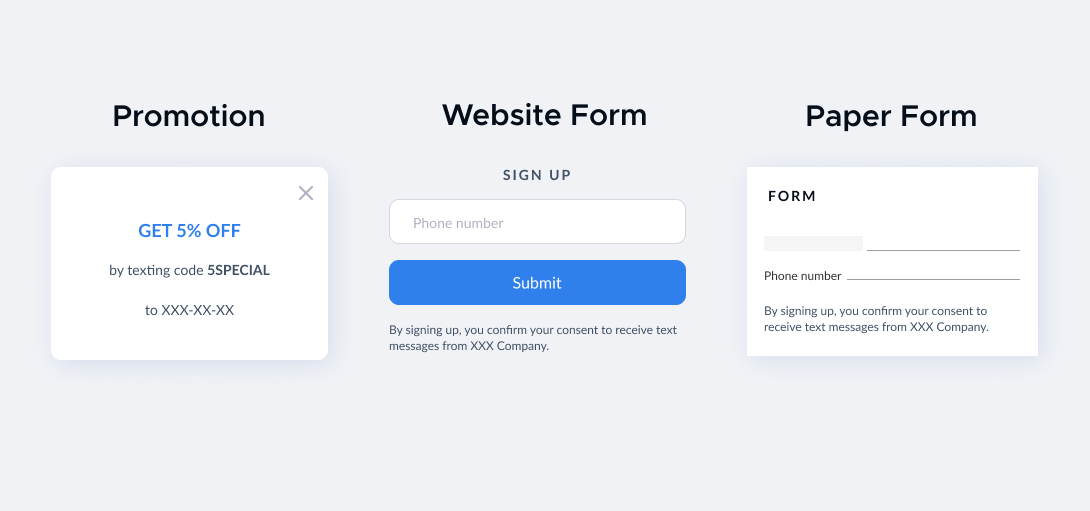
If using SMS, you’ll also need to update relevant legal pages like terms of service and privacy policy, with details on how SMS consent will be handled.
Many countries may have additional regulations. For the US, all SMS messaging in The United States of America is governed by the CTIA – The Wireless Association.
The CTIA is an association of mobile carriers that set rules and best practices for the text marketing industry. One of these rules applies to message content and is known as SHAFT – sex, hate, alcohol, firearms, and tobacco. Including content related to any of these topics in your call-to-action or any of your messages is considered one of the highest violations, and may result in an immediate ban.
Make sure to check these regulations for your country before setting up massive outreach.
Getting started with an SMS Chatbot
To run an SMS chatbot, you will need a dedicated phone number. Better use a new one and leave it for a chatbot only.
The next step is to decide on the implementation method. To run an SMS chatbot, you’ll need a platform or a vendor to set it up. The most popular choices are a chatbot platform or a chatbot development company.
With the platform, you’ll be able to set up the chatbot yourself or with minimum help from developers. It’s a great choice for SMS marketing or simple campaigns with a clear goal. With a platform, you’ll get a quick start. Usually there are plenty of online materials that will guide you through the process.
Although, note that scaling campaigns later on or adding integrations may be not so easy with a platform. You may require custom development that comes with additional costs. It’s hard to predict when your plan pricing is going to jump from “basic” to “custom”. Make sure the platform includes all the necessary integrations and functionality before building a chatbot.
With a chatbot development company, you’ll get a full setup and optimization for your SMS chatbot from a development team. It’s a good choice for a long run or for businesses that already use some kind of a chatbot, have additional integrations or require a more complex chatbot.
Getting started with a custom chatbot is more expensive than a platform as you get support of developers, conversational and UI/UX designers. They will analyze your company and needs, investigate your software ecosystem, build the roadmap and plan the ROI. With a team, the chances to build a successful chatbot become higher.
To check if the investment for a chatbot is worth it, companies offer a discovery phase. While you don’t pay the full price of a chatbot, the team sets a chatbot in a proper way so you could evaluate the opportunity in a month or two.
The best way to choose the best one is to check in with both options. In case you’re considering one now, do not hesitate to contact us for a consultation. Our chatbot expert will go through your needs together and help you qualify the highest ROI solution for your business needs.




